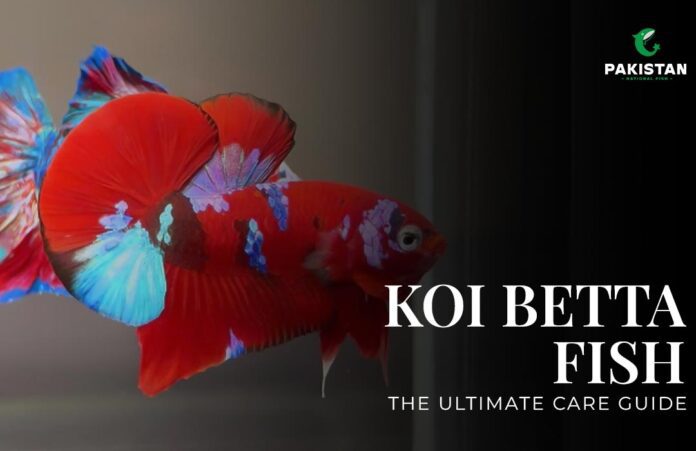Koi betta is not a distinct type of betta fish, but rather a knowingly produced variant of the Betta splendens. To achieve this multi-coloured appearance, koi bettas are sometimes combined with other Betta varieties with colour patterns similar to those of koi carp. However, their proportions are more ‘friendly’ to home fish aquariums than carp koi, at only about 2.5-3 inches. It’s five times smaller than a Koi carp!
Koi Betta fish are a colour variety of Betta splendens recognized for their stunning marbled patterns, which resemble those of Koi carp. These patterns are the product of a genetic abnormality called “marble,” which leads to the fish’s colours varying and shifting over time. This distinguishing characteristic makes each Koi Betta genuinely unique.

Name and History of Koi Betta Fish
According to its name, the koi betta is not a cross between a betta fish and a koi carp. This fish originates its name from the way its colouring resembles koi. The marbling is quite similar to that of a koi carp. Yet, koi bettas are 100% betta, often known as Siamese fighting fish. Koi betta fish have distinct colours as a result of a combination of diverse marble betta varieties. The marbling is created by a “jumping gene,” which can make colours unpredictable.
Orville Gulley, an inmate at Indiana State Prison, developed this colouring variant in the 1970s. Gulley raised bettas as part of his recovery efforts and discovered the marbling gene while attempting to produce a black butterfly betta. The first marble bettas were purely black and white; the orange and red colouring was introduced later.
Size and Appearance
Koi bettas have a greater variety of colours than typical marbled bettas. They may be white with black, red, orange, or yellow streaks. Fancy koi bettas may also have green and blue spots. The galaxy-shaped koi betta fish is one of these beautiful varieties of the koi betta.
Koi betta fish are short-finned instead of long-finned, growing to be around 3 inches long. Male bettas have larger, longer, and denser lateral fins.
Behaviour and Character
All betta fish are extremely obsessive and aggressive, and the koi betta is among them. These Siamese fighting fish stand up to their names. Males ought not to be housed together since they will frequently fight till the death. Even coupling a male and a female might lead to death if the mating chase becomes hostile.
Bettas should be introduced into existing tanks to prevent them from fighting with new fish. However, certain koi betta fish will not tolerate tank mates and will only thrive when maintained alone. Male koi bettas are more violent than females, and they should be kept alone if they want to coexist happily.
The feeding
Wild Koi Betta consume insects and larvae in captivity, they may survive on crushed food, fish flakes, or different types of fish feeds but they prefer live or frozen bloodworms, larvae of mosquitoes, brine shrimp, and this species. Follow the directions given on fish food for the amount of food to feed your koi betta.
Tips for Maintaining Aquarium for Koi Betta Fish
Providing an appropriate environment for your Koi Betta is extremely important for their well-being.
Here’s the way to set up the ideal aquarium for oi Betta fish.
- The minimum tank size is 5 gallons. Larger tanks are favoured because they provide more secure water conditions and allow the fish to explore more freely.
- Betta fish like lengthy aquariums with a large surface area for maximum oxygen exchange.
- To protect your Betta’s fragile fins, choose a soft substrate such as sand or smooth pebbles and add plants for the fish Aquarium.
Breeding of Koi Betta
When the male betta fish has finished creating a bubble nest, the time has come to introduce the female. If the female koi betta adores the nest, all is well, and the process of mating might last up to 6 hours. If not, she will refuse breeding or lose interest in the male. If you notice any chasing or biting, you can add more decorations to hide or separate the two.
Because female and male Koi Betta fish do not get along very well, you need to keep a close eye on them during the procedure. Once the task is completed, they should be segregated into separate tanks. Below are a few tips for taking care of the fry:
- The Hatching: The eggs will hatch within 24-48 hours. The fry will stay in the nest for a few days until they can swim freely.
- Nourishing Fry: Feed the fry infusoria or commercially accessible fry food until they are large enough to consume baby brine shrimp or finely smashed flakes.
- Tank Maintenance: Tank maintenance includes keeping the water clean and regularly monitoring the water parameters to guarantee the fry’s health.
Conclusion
Koi Betta fish are a beautiful and engaging species that may survive with proper care and conditions. Knowing their needs and providing a proper environment, balanced feed, and constant health monitoring will allow you to appreciate the beauty and distinctive character of these fish for years to come.


